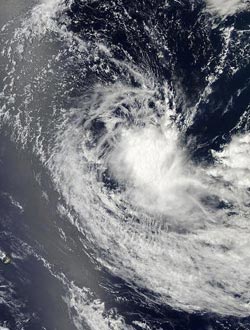NASA catches glimpse of the brief life of Southern Indian Ocean's first tropical cyclone

The MODIS instrument aboard NASA's Aqua satellite captured this visible image of Tropical Cyclone 01S in the South Indian Ocean. The image was taken on Oct. 27 at 09:30 UTC/4:30 a.m. EDT.<br><br>Credit: NASA Goddard MODIS Rapid Response Team<br>
The first tropical cyclone of the Southern Indian Ocean cyclone season formed on Oct. 27 near 13.1 south and 63.4 east, about 570 nautical miles northeast of Port Louis, Mauritus. It was moving to the west-southwest at 7 knots. Maximum sustained winds were near 35 knots.
On Oct. 27, satellite imagery showed that the low-level circulation center is elongated indicating the system was battling wind shear. Satellite imagery revealed that the strongest convection was around the southern edge of the center. Maximum sustained winds were near 35 knots/40 mph/64.8 kph and the storm was moving west.
The Moderate Resolution Imaging Spectroradiometer or MODIS instrument aboard NASA's Aqua satellite captured a visible image of Tropical Cyclone 01S in the South Indian Ocean. The image was taken on Oct. 27 at 09:30 UTC/4:30 a.m. EDT and showed an elongated storm.
On Oct. 28 at 0000 UTC/Oct. 27 at 8 p.m. EDT, Tropical Cyclone 01S was located near 13.1 south latitude and
62.5 east longitude, approximately 550 nautical miles north-northeast of La Reunion Island. Despite the maximum sustained winds near 35 knots/40 mph/64.8 kph, the storm was weakening and was expected to weaken because of wind shear.
Media Contact
More Information:
http://www.nasa.govAll latest news from the category: Earth Sciences
Earth Sciences (also referred to as Geosciences), which deals with basic issues surrounding our planet, plays a vital role in the area of energy and raw materials supply.
Earth Sciences comprises subjects such as geology, geography, geological informatics, paleontology, mineralogy, petrography, crystallography, geophysics, geodesy, glaciology, cartography, photogrammetry, meteorology and seismology, early-warning systems, earthquake research and polar research.
Newest articles

Why getting in touch with our ‘gerbil brain’ could help machines listen better
Macquarie University researchers have debunked a 75-year-old theory about how humans determine where sounds are coming from, and it could unlock the secret to creating a next generation of more…

Attosecond core-level spectroscopy reveals real-time molecular dynamics
Chemical reactions are complex mechanisms. Many different dynamical processes are involved, affecting both the electrons and the nucleus of the present atoms. Very often the strongly coupled electron and nuclear…

Free-forming organelles help plants adapt to climate change
Scientists uncover how plants “see” shades of light, temperature. Plants’ ability to sense light and temperature, and their ability to adapt to climate change, hinges on free-forming structures in their…





















